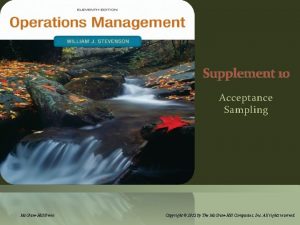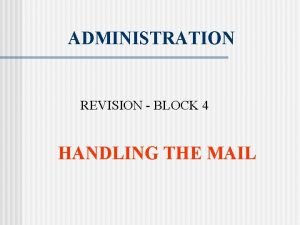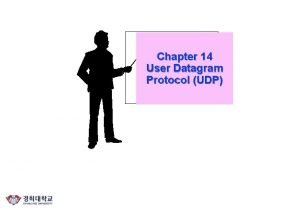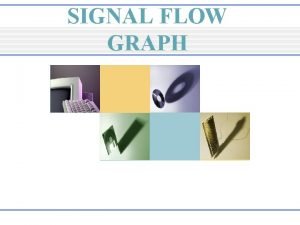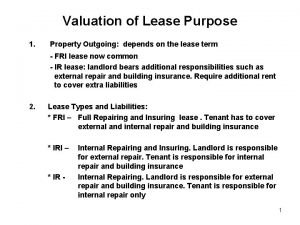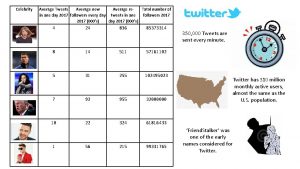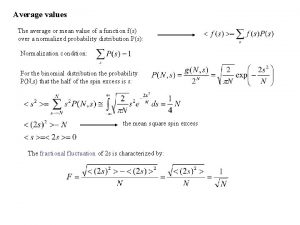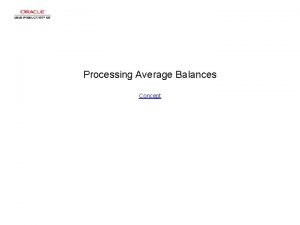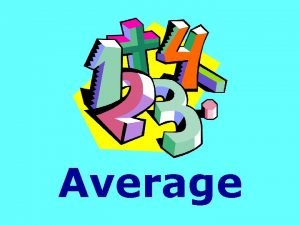Average Outgoing Quality Outline Average Outgoing Quality AOQ














- Slides: 14

Average Outgoing Quality Outline • Average Outgoing Quality (AOQ) • Average Outgoing Quality Limit (AOQL) • Average Total Inspection (ATI) • Average Fraction Inspected (AFI) 1

Average Outgoing Quality • If a lot is accepted, it may contain some defective items. Many of the items (N-n items in a single sampling plan) not inspected may be defective. • The items which are inspected and found defective, may be – Case 1: returned to the producer or – Case 2: repaired or replaced by the producer. • We assume Case (2). 2

Average Outgoing Quality • If a lot is rejected, it may be subjected to a 100% inspection. Such action is referred to as screening inspection, or detailing. This is sometimes described as an acceptance/rectification scheme. • Again, There may be two assumptions regarding the defective items. The defective items may be – Case 1: returned to the producer or – Case 2: repaired or replaced by the producer. • We assume Case 2. So, if a lot is rejected, it will contain no defective item at all. The consumer will get N good items. 3

Average Outgoing Quality • Thus, if there is an average of 2% defective items, the accepted lots will contain little less than 2% defective items and rejected lots will not contain any defective item at all. On average, the consumer will receive less than 2% defective items. • Given a proportion of defective, p the Average Outgoing Quality (AOQ) is the proportion of defectives items in the outgoing lots. More precise definition is given in the next slide. 4

Average Outgoing Quality 5

Average Outgoing Quality Case 1 is not discussed in class 6

Average Outgoing Quality 7

Average Outgoing Quality • Given a proportion of defective, we can compute the Average Outgoing Quality (AOQ) • As p increases from 0. 0, the AOQ values increases up to a limit called Average Outgoing Quality Limit (AOQL), after which the AOQ values descend continuously to 0. 0. This is shown in the next slide. 8

AOQ Curve and AOQL 0. 015 AOQL Average Outgoing Quality 0. 010 0. 005 0. 01 0. 02 AQL 0. 03 0. 04 0. 05 0. 06 0. 07 0. 08 0. 09 0. 10 LTPD (Incoming) Percent Defective 9

Example: Suppose that Noise King is using rectified inspection for its single sampling plan. Calculate the average outgoing quality limit for a plan with n=110, c=3, and N=1000. (Assume that the defective items are replaced) 10

11

12

ATI and AFI • Average Total Inspection (ATI) • Average Fraction Inspected (AFI) • Relationship between AOQ and AFI 13

Reading and Exercises • Chapter 11 – Reading: all – Problems: 11. 3, 11. 4, 11. 7, 11. 9, 11. 11, 11. 17 Notes: • Disregard the reference to hypergeometric distribution in 11. 17 • Use Excel for repetitive calculations in 11. 3, 11. 4, 11. 11 and 11. 17 14
 Aoq formula
Aoq formula Cqe primer
Cqe primer Sandwich quotation
Sandwich quotation What is the difference between speed and velocity
What is the difference between speed and velocity Easygoing vs outgoing
Easygoing vs outgoing Olr earth
Olr earth Outgoing adoptions
Outgoing adoptions Incoming sensory impulses and outgoing motor impulses
Incoming sensory impulses and outgoing motor impulses My sister is more outgoing than my brother because
My sister is more outgoing than my brother because Procedures of handling outgoing mail
Procedures of handling outgoing mail Udp uses to handle outgoing
Udp uses to handle outgoing Maverick personality
Maverick personality Outgoing payment
Outgoing payment Signal flow graph problems
Signal flow graph problems What is outgoings in valuation
What is outgoings in valuation
